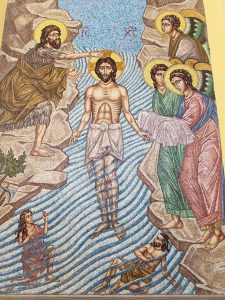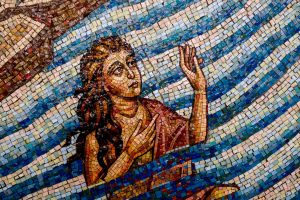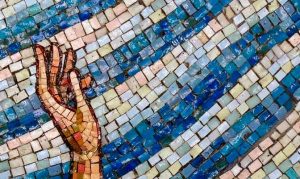
“The Holy Theophany (Epiphany) of Our Lord,” in the Greek Orthodox Tradition. Photo taken by Emmanuel Petkas.

“The Sea” in the “The Holy Theophany (Epiphany) of Our Lord,” in the Greek Orthodox Tradition. Photo taken by Emmanuel Petkas.
I don’t how I came across this picture, but, when I first saw it, I fell in love with it. Everytime I look at it, it caresses my soul reminding me of God’s beauty. It also moved me to find out who was the architect behind it, where the mosaic tile is kept, and what it means.
So this is what I discovered: Iconographer Sirio Tonelli is the artist; it adorns the south wall of the Greek Orthodox Cathedral of the Annunciation, a community of the metropolis of Atlanta in the Greek Orthodox Archdiocese of America; and the woman is a personification of the word “sea” from the psalms. Psalm 114:3 says, “The sea looked and fled, the Jordan turned back” (NIV). In the Septuagint (the Koine Greek translation of the Hebrew Bible), “the sea” (ἡ θάλασσα) has a feminine article. And thus, in the picture, the woman is depicted as the sea.
Originally, I came across only a portion of the picture, which is of a feminine hand being held up toward Christ. Ironically, the mood of the verse is one of fear, but the depiction of the icon is one of serenity.

Feel the emotion of the hand as the light dances through her fingers and warmly engulfs it; it looks as it’s completely content; it enjoys sweet surrender; it’s, in a word, “flourishing.”
I want to thank Emmanuel Petkas for sending me a picture of The Epiphany. My goal is to one day take a tour of the Greek Cathedral in Atlanta, Georgia, where the mosaic continues to mesmerize parishioners and guests with its iconic beauty and grace.